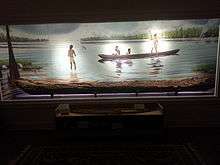Cades Pond culture

The Cades Pond culture is defined as a Middle Woodland Southeast period archaeological culture in north-central Florida, dating from around 100 to 600 CE.
Geography
The Cades Pond culture is found in an area roughly corresponding to present-day eastern Alachua County, the northern half of Marion County and the western part of Putnam County.[1]
Cades Pond sites are located adjacent to lakes and wetlands, often between lakes and wetlands. Cades Pond villages are often associated with mounds. Some of the villages include earthworks associated with mounds and burial areas. Other villages were near mounds, while some villages had no associated mound. Villages appear to have been occupied for long periods, and included large storage pits.[2]
Mounds and village sites of the Cades Pond culture have been found near River Sink on the Santa Fe River, Lake Santa Fe, between Paynes Prairie and Newnans Lake (Gainesville), between Paynes Prairie and Levy Lake (Wacahoota), and between and around Orange Lake and Lochloosa Lake (Cross Creek, Hawthorne, Evinston and the River Styx).[3]
History
The Cades Pond culture was preceded by the more widely-spread Deptford culture, and succeeded by the Alachua culture, which covered approximately the same area. The area of the Cades Pond culture was used intermittently by Deptford culture people prior to 100 CE. Late Deptford people established permanent villages in the area around 100 and the Cades Pond culture developed out of the Deptford culture. Weeden Island ceremonial pottery appeared in Cades Pond mounds around 300 CE. Pottery found in Cades Pond villages and middens was largely undecorated, and resembled contemporary ceramics of the St. Johns culture. Around 600 the Cades Pond culture was replaced by the unrelated Alachua culture.[4][5][6]
Culture
The Cades Pond culture is distinguished by its pottery and stone tools, and by the siting of its villages. Pottery found at Cades Pond sites consists primarily of large, undecorated bowls. Stone tools include hafted knives and scraping tools, perforators, triangular knives, manos and metates and sandstone abraders. Bone tools include double-pointed leisters, splinter awls, perforators, flakers, deer ulna awls, scrapers or fleshers, punches, and fids. Shell columella (the central column of a conch or whelk shell, often used as a hammer) and tools with shark's teeth have also been found.[7]
The Cades Pond people heavily exploited the aquatic resources of their environment. Eighty-five percent of the 1500 individual animals used for food at one site came from aquatic habitats. Included were snails, clams, 12 species of fish, frogs, 7 species of turtles, 5 species of water snakes, alligator, 7 species of water birds, otter, and muskrat. Land animals consumed included deer, black bear, panther, opossum, rabbits, squirrel, skunk, rats, and foxes. Identified plant remains include hickory (especially mockernut hickory), pine nuts, acorns, Chickasaw plum, persimmon, and wild cherry (Carolina cherry laurel). There is no evidence that the Cades Pond people cultivated any crops.[8]
Notes
- ↑ Milanich 1995: 26
- ↑ Milanich 1995: 228-29
- ↑ Hemmings: 142-43
- ↑ Anderson, David G.; Robert C.Mainfort Jr., eds. (2002). The Woodland Southeast. University of Alabama Press. p. 369. ISBN 0-8173-1137-8. Retrieved 3 October 2012.
- ↑ Milanich 1994: 228-29, 333
- ↑ Milanich 1995: 28, 163, 228-29
- ↑ Milanich 1995: 232, 235
- ↑ Milanich 1995: 229-32
References
- Hemmings, E. Thomas (December 1978). "Cades Pond Subsistence, Settlement, and Ceremonialism". The Florida Anthropologist. 31 (4): 141–150. Retrieved 3 October 2012.
- Milanich, Jerald T. (1994). Archaeology of Precolumbian Florida. Gainesville, Florida: University Press of Florida. ISBN 0-8130-1273-2.
- Milanich, Jerald T. (1995). Florida Indians and the Invasion from Europe. Gainesville, Florida: University Press of Florida. ISBN 0-8130-1360-7.
- Milanich, Jerald T. (1998). Florida's Indians from Ancient Times to the Present. Gainesville, Florida: University Press of Florida. ISBN 0-8130-1599-5.
